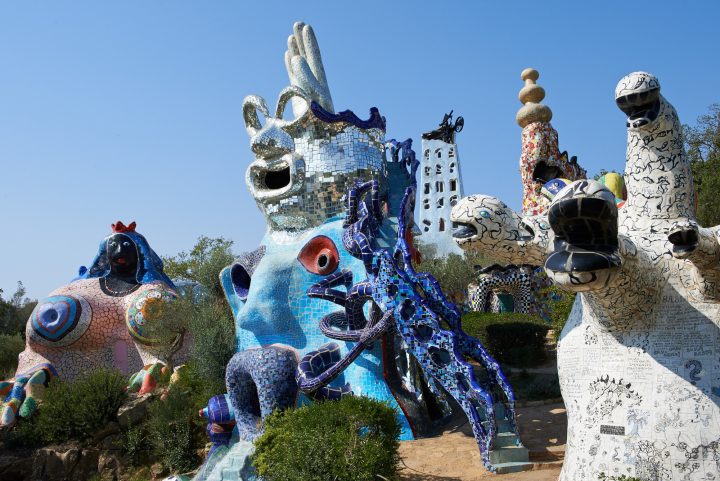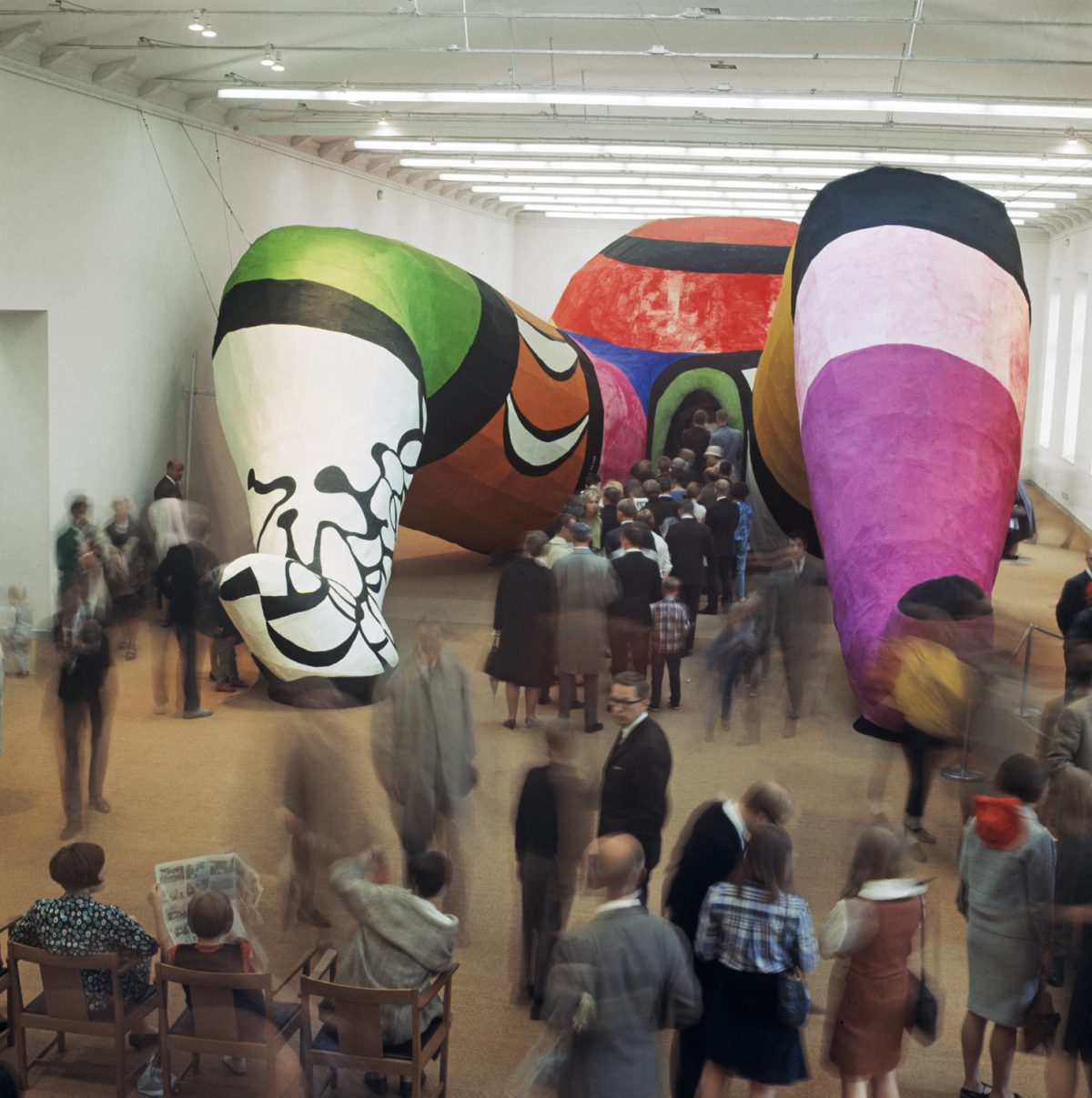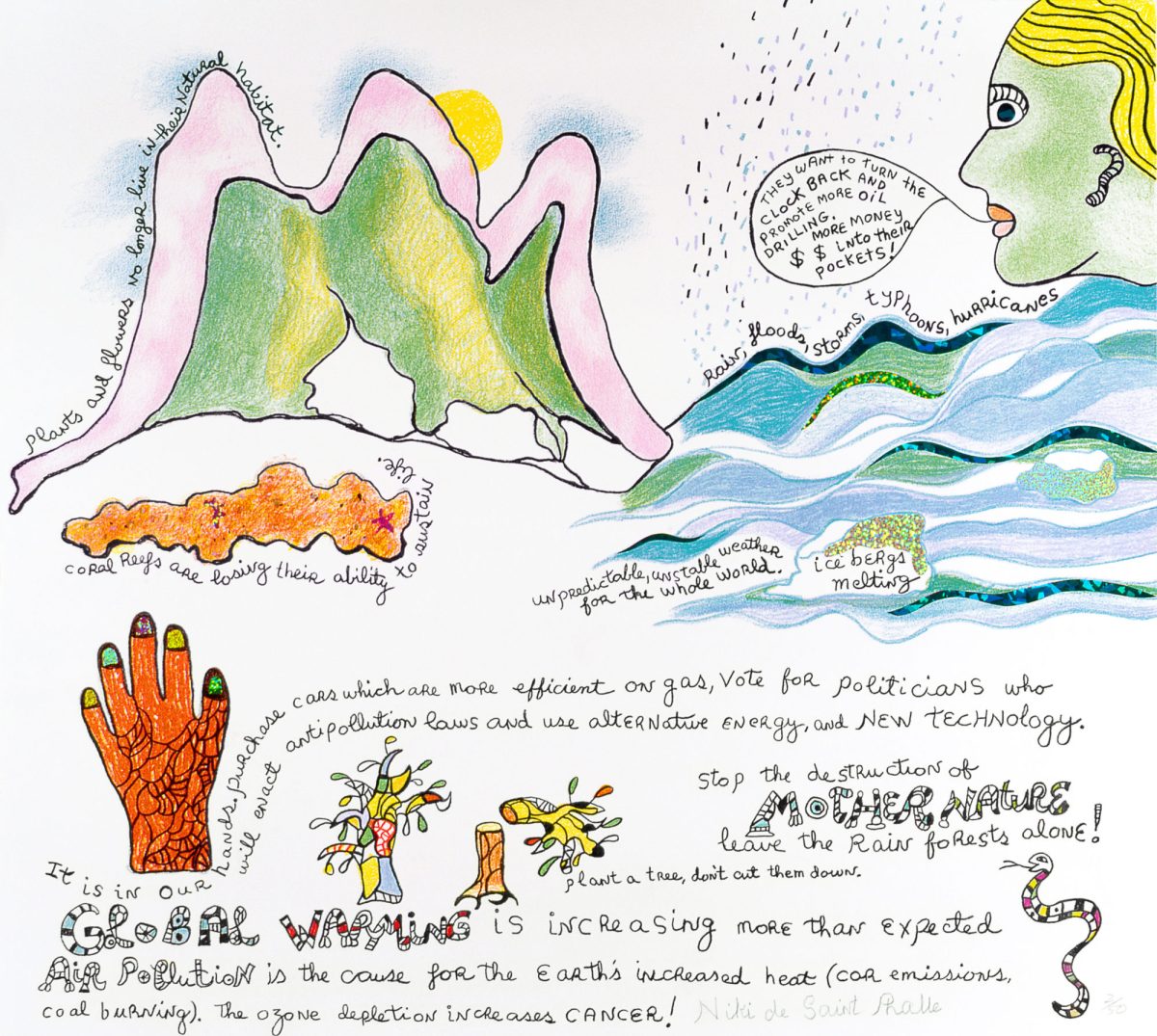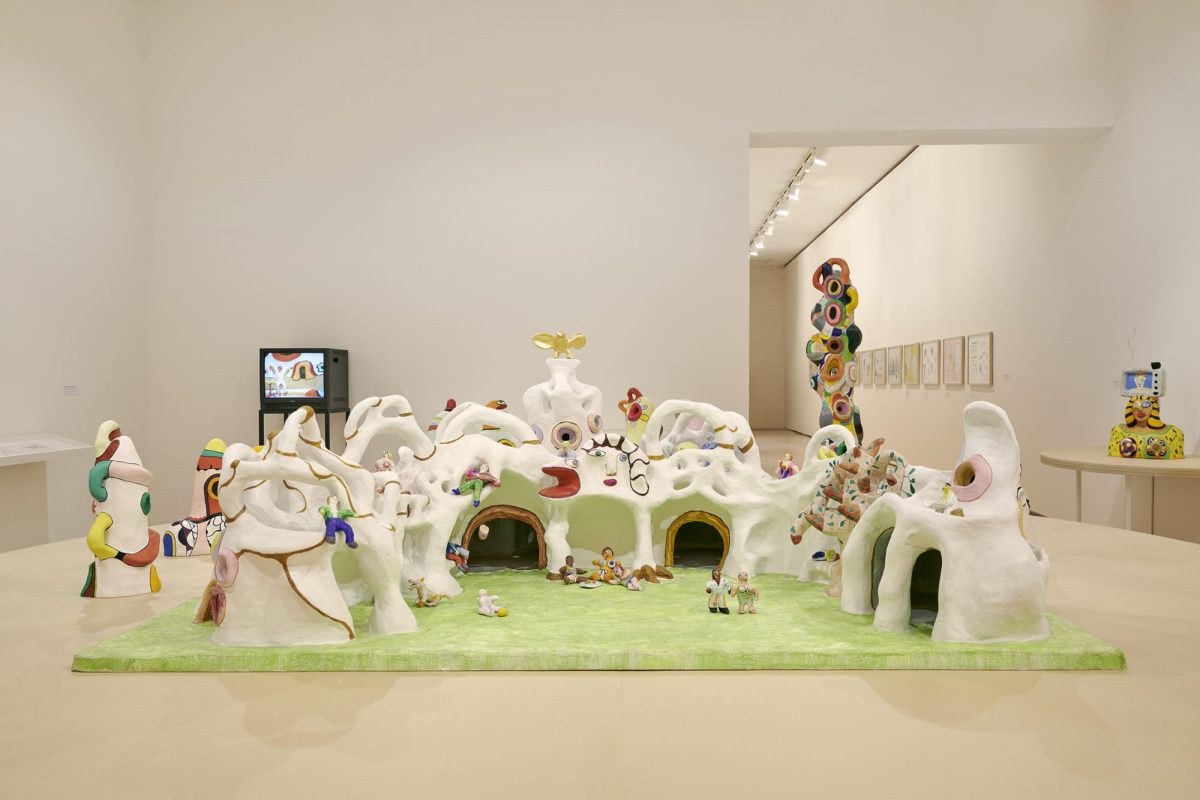
In the final gallery of MoMA PS1’s retrospective of Niki de Saint Phalle, the French-American artist narrates a film documenting her lifework. Between descriptions of her practice and preferred interpretations of certain pieces, Saint Phalle’s voiceover nonchalantly references her childhood and influences. “I was brought up on fairy tales,” she tells audiences. “I identify with the fool in the fairy tales who takes risks.” Such childlike daring underscores a divide in Saint Phalle’s popular reception — much beloved by children yet dismissed by certain adults as garish, naïve, or even offensive. This paradox is highlighted at the start of the exhibition by photographs of smiling children scrambling atop and whizzing down the tongue-shaped slides of Saint Phalle’s “Golem” playground in Jerusalem (1972) coupled with newspaper speculation that such monstrous forms might make youth aggressive. Nearby, in reaction to “Le rêve de l’oiseau” (1968-71), a summer home built for a friend in southern France, a headline makes the blunt accusation: “Who authorized this horror?”

Saint Phalle and her art were no stranger to controversy. In contrast to the masculine, mechanical work of her partner, Jean Tinguely, Saint Phalle’s practice was often characterized as feminine and amateurish. In archival footage, an interviewer describes her oeuvre as innocent and erotic, playful yet serious. At PS1, the curation is also structured by oppositions: fear and pleasure, technology and nature, life and death. The Nanas series (1964-74), arguably Saint Phalle’s best known work, encouraged such responses; variously produced as weightless balloons or weighty sculptures, these female forms are at once comforting maternal figures and curvaceous femmes fatales. Yet the contribution of this show is its ability to move beyond Saint Phalle’s most acclaimed works. As its title suggests, Structures for Life introduces viewers to the artist’s large scale, site-specific projects, and invites them into her multidimensional universe.

Collages, video, and architectural maquettes illustrate the development of the coded yet accessible language of motifs appearing throughout Saint Phalle’s art. One unrealized design for a children’s hospital proposes a technicolor chutes-and-ladder world, populated by dragons, snakes, and spiders. These characters are neither defined as obstacles or assets but are left open-ended, inviting interpretation and engagement. Similarly, Saint Phalle’s own traumas of childhood sexual abuse and later electroconvulsive therapy are alluded to but never fully summoned. (It bears mention that these events, although discussed in French-language sources exhibited, are not translated to the catalogue or wall text.) Saint Phalle came closest to realizing an alternate world with her “Tarot Garden” (1979-2002), a sprawling sculptural site outside Rome. Visually indebted to Gaudi’s Parc Guell, the “Garden” was a playful space of color, fate, and friendship, inhabited by the archetypal forces of the tarot deck and predicated upon community. The accompanying tarot cards demonstrate Saint Phalle’s comprehensive commitment, building not only new structures but even new languages for her utopian environments.

Extending focus to smaller, sensory objects, Structures for Life exhibits Saint Phalle’s designs for jewelry and perfume in an antechamber to the main gallery. The curators situate the production of these wares in the lineage of multiples and as ingenious funding schemes for the creation of Saint Phalle’s larger projects, simultaneously enabling a range of admirers to own her art and liberating the artist from the bonds of patronage. But they also illustrate a translation in scale from totemic sculptures to talismanic objects worn on the body, perhaps as armor or, as Saint Phalle labeled them, lucky charms. The artist’s world is framed as both intimate and expansive, with personal gestures balancing the louder, monumental interventions. Dispersed throughout the exhibition, a series of illustrated letters to her friend, Clarice Rivers, underscore the importance of writing to Saint Phalle’s psyche and practice. Inscribed and colored with a childlike hand, these missives seem to serve a diaristic or therapeutic purpose, making the addressee at once private and public.
This style of address dominates her later production, here exhibited as visual commentary on everything from abortion, hunger, global warming, gun violence, to mass incarceration. Saint Phalle raises all the issues that adults learn to tolerate and “live with,” but which children constantly question or even refuse to accept. The artist demonstrates that being childlike isn’t necessarily backwards or bad; we should be horrified and we should constantly question. Acerbic condemnation of Catholicism’s role in these matters motivates two altarpieces. In the brightly colored “The Plague,” the religious structure is transformed into a memorial to queer individuals condemned by the Church and living with AIDS, while “O.A.S.” — its title a tongue-in-cheek reference to an oeuvre d’art sacrée and the Organisation Armée Secrète — stages a blasphemous revelation of religious support of the rightwing terrorist group that sought to maintain French colonial control in Algeria.

In response to these horrors, Saint Phalle invites us to imagine a new matriarchal world premised upon acts of nurture and bonds of collectivity. The Nana houses and infamous Nana cathedral exhibited in Stockholm in 1966 best illustrate such possibilities, and are imbued with joy and humor, performativity and collaboration. They disavow the societal binaries that limit women to the status of Madonna or whore, and, by extension, undercut the heavy-handed readings that critics have applied time and again to Saint Phalle and her art. Thanks to its non-chronological approach and deep plunge into the artist’s wider world, Structures for Life frees Saint Phalle from the triadic body-beauty-biography interpretative lens that reduces her to a feminist painter and sculptor. In fact, Saint Phalle dreamed much bigger and at times, her dreams became reality.

Niki de Saint Phalle: Structures for Life continues through September 6 at MoMA PS1 (22-25 Jackson Avenue, Long Island City, Queens). The exhibition is curated by Ruba Katrib with Josephine Graf.
0 Commentaires